Light Adaptation
1/67
There's no tags or description
Looks like no tags are added yet.
Name | Mastery | Learn | Test | Matching | Spaced |
|---|
No study sessions yet.
68 Terms
Both dark and light adaptations are all about perception of what?
brightness
process of the visual system adapting to changes in light level (but not going from photopic to scotopic conditions)
light adaptation
If we go outside from a bright indoor environment, there is a significant change in what photometric value? Even though both are photopic conditions, does light adaptation still happen?
illuminance, yes
(it's just a very smooth transition, so it doesn't seem too different to us)
If we go outside from a bright indoor environment, how does our brightness perception change? (Hint: they are both examples of photopic conditions)
remains relatively constant
True or false: Color perception stays pretty much the same despite varying illumination conditions.
true
(regardless of whether we're inside or outside, we would describe white, silver, and black objects as the same color regardless of lighting)
True or false: Luminance stays pretty much the same despite varying illumination conditions.
false
As illuminance increases, does luminance increase or decrease?
increase
True or false: Our visual system does not process luminance information based on absolute values.
true
(since varying luminance doesn't vary our perception of color or brightness)
True or false: Our brightness perception remains relatively stable as long as lighting conditions are roughly the same (e.g., both photopic).
true
refers to the phenomenon in which when stepping outside from a well-lit indoor environment, more light enters our eyes, but despite the tremendous change of light level, objects have the same appearance.
lightness constancy
What two qualities of an object generally remain constant despite tremendous changes in illumination?
lightness, reflectance
What phenomenon is responsible for a gray object appearing gray across wide changes in illumination?
lightness constancy
What 2 underlying processes allow lightness constancy to happen?
light adaptation, contrast processing
Which is faster: light or dark adaptation?
light
(must occur quickly so that objects can be detected/perceived against different levels of ambient lighting)
What is the general purpose of light adaptation?
allows visual system neurons to perform well at any given level of illumination
How can we study the light adaptation process of the visual system?
measure how threshold changes after adapting to a different light level
(increment threshold procedure)
refers to a brightness threshold against a given background light intensity; how much brighter something needs to be to detect it against a background
increment threshold
What is the increment threshold (IT) procedure to measure light adaptation?
select background luminance intensity, present a probe in the center, have observer figure out minimum luminance at which probe is perceived as brighter than the background
What 4 psychophysical techniques can be used to measure increment threshold?
MOL, MCS, MOA, staircase
(all of these can be paired with FC too)
How can we use descending MOL to measure increment threshold?
probe starts with high luminance, reduce in increments and ask subject each time if they can perceive the brighter spot in the center until they say no
How can we use descending MOA to measure increment threshold?
probe starts with high luminance, subjects adjusts luminance until probe is seen as just brighter than background
How could you measure increment threshold using MCS?
have observer figure out minimum luminance at which probe is perceived as brighter than the background by presenting a selection of pre-set conditions in each trial
What specific testing measures increment threshold using the staircase procedure?
automated perimetry
When measuring light adaptation, after an increment threshold has been determined, what is the next part of the procedure?
increase background intensity and repeat measurements, keep doing this for different background light levels
A light adaptation curve shows increment threshold as a function of what?
background adapting intensity
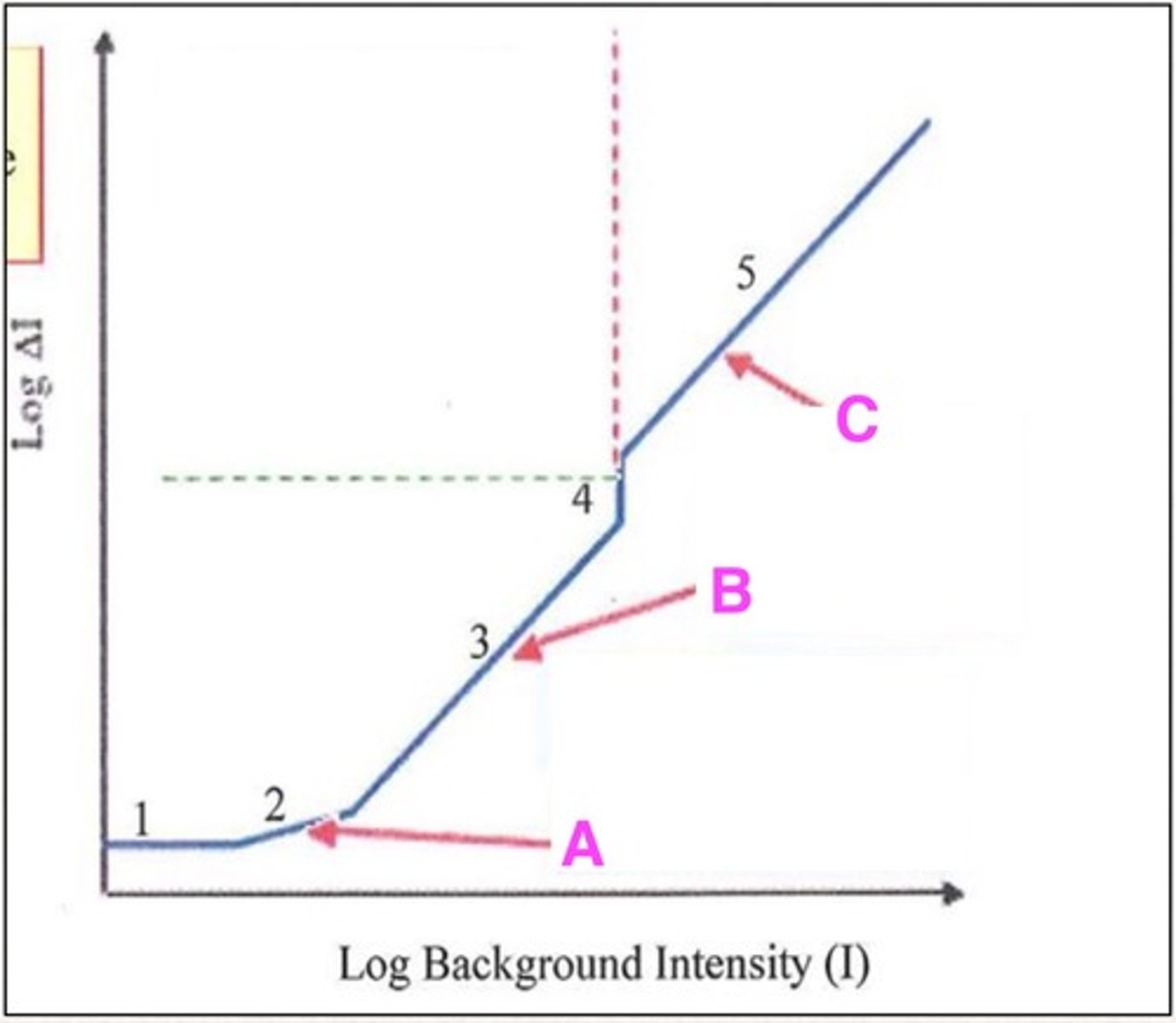
What is on the x-axis of a light adaptation curve?
log background intensity
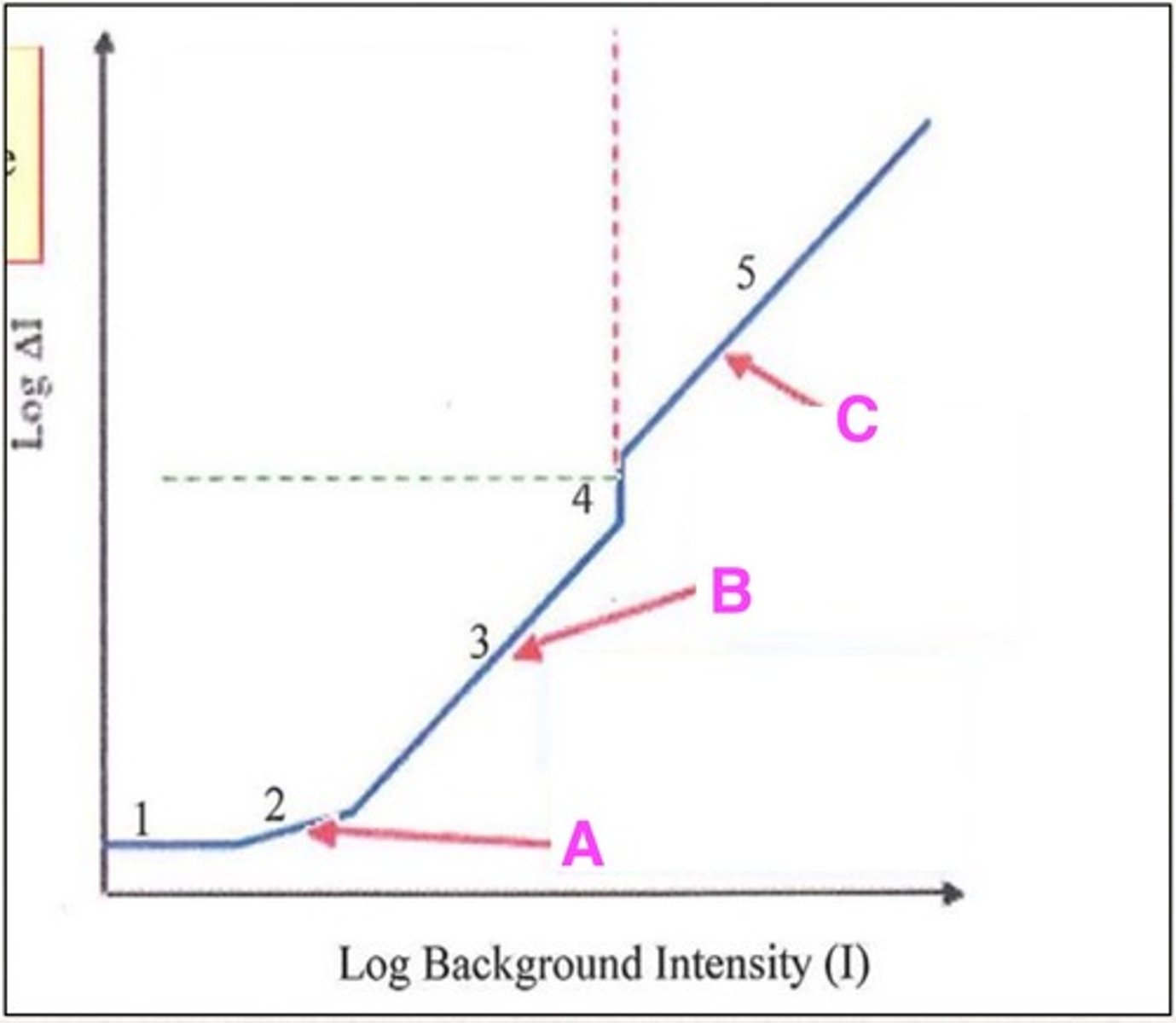
What is on the y-axis of a light adaptation curve?
log increment threshold
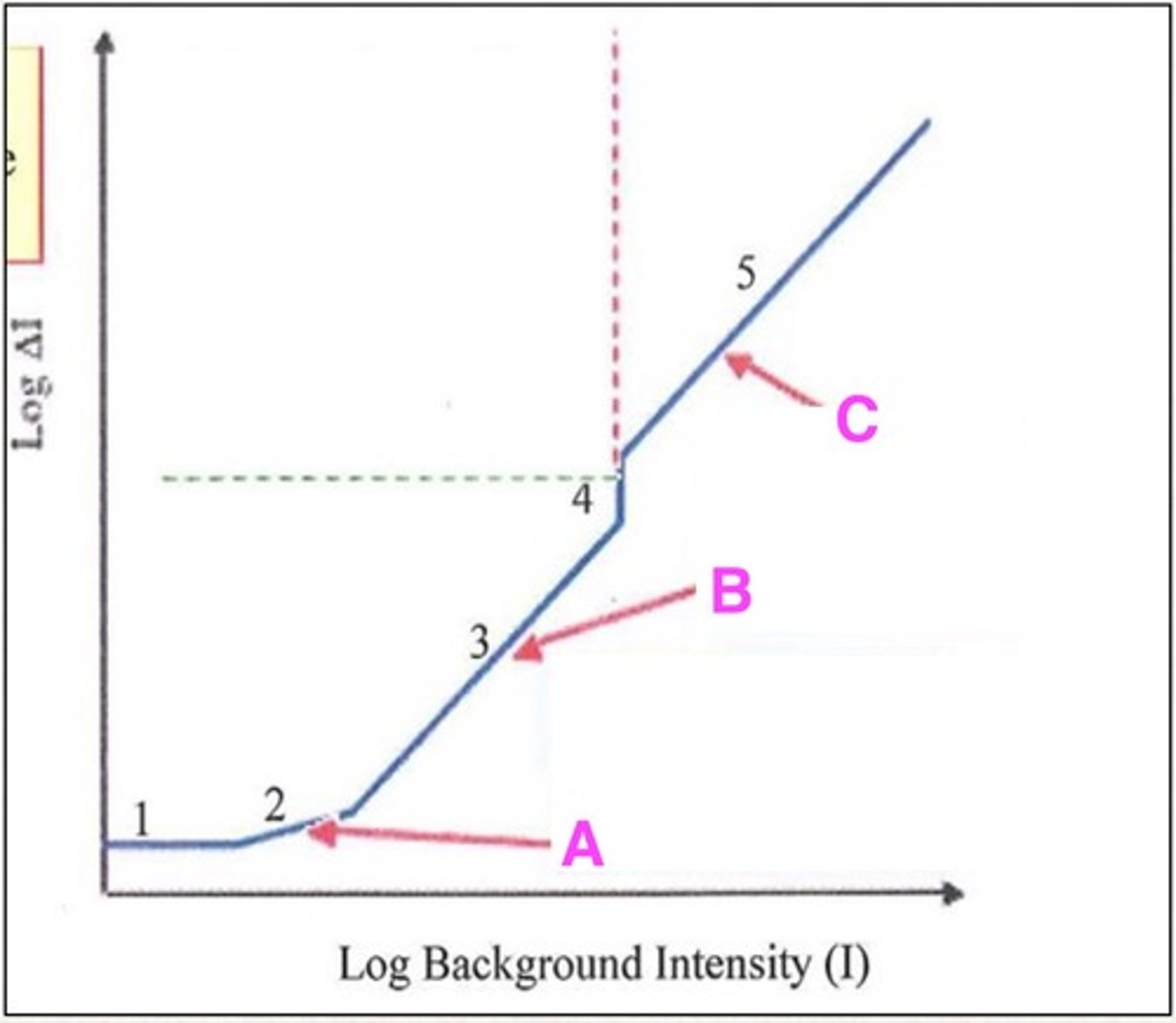
On this light adaptation curve, which regions correspond to scotopic light adaptation?
1, 2, 3, 4
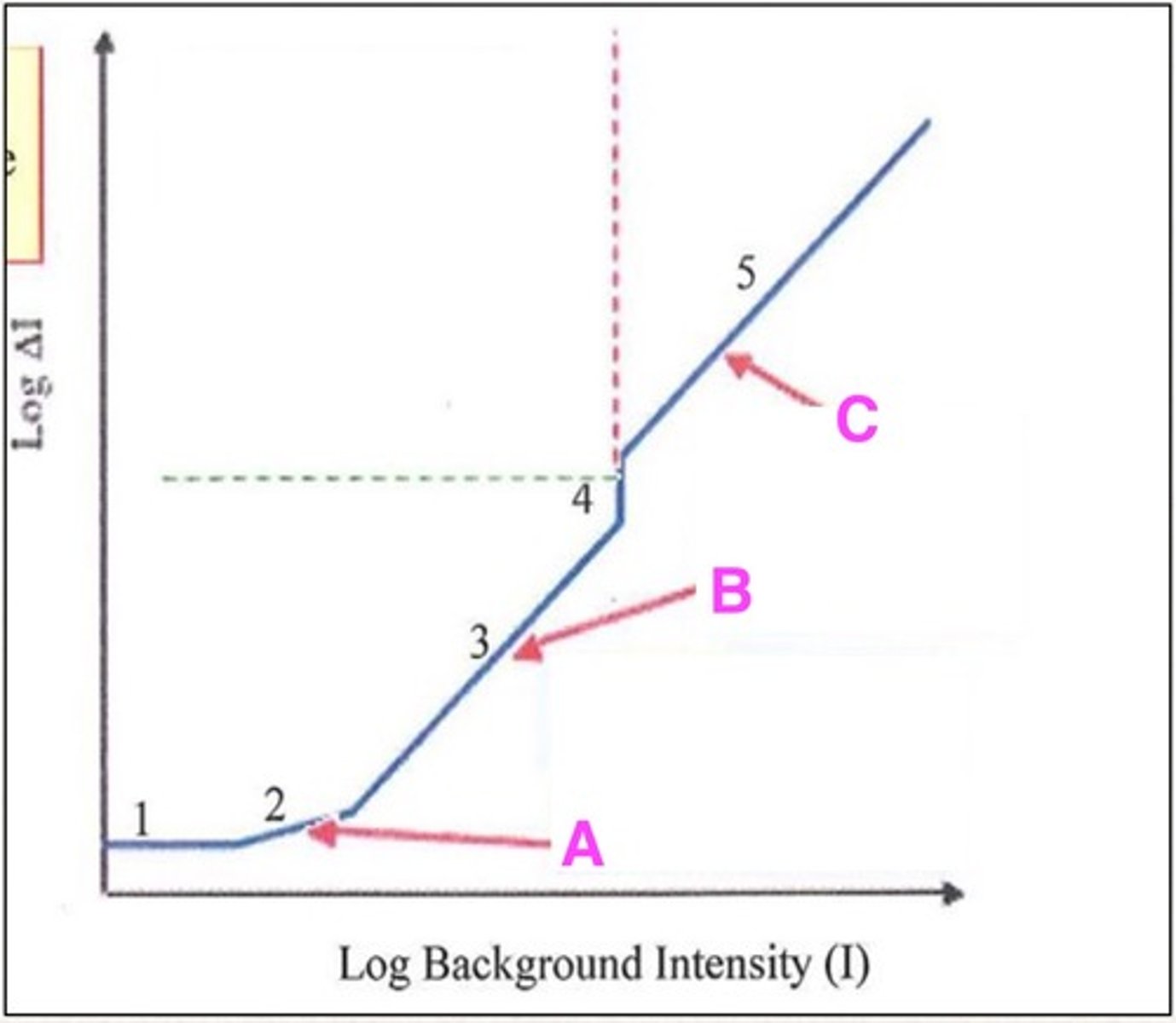
On this light adaptation curve, which regions correspond to photopic light adaptation?
5
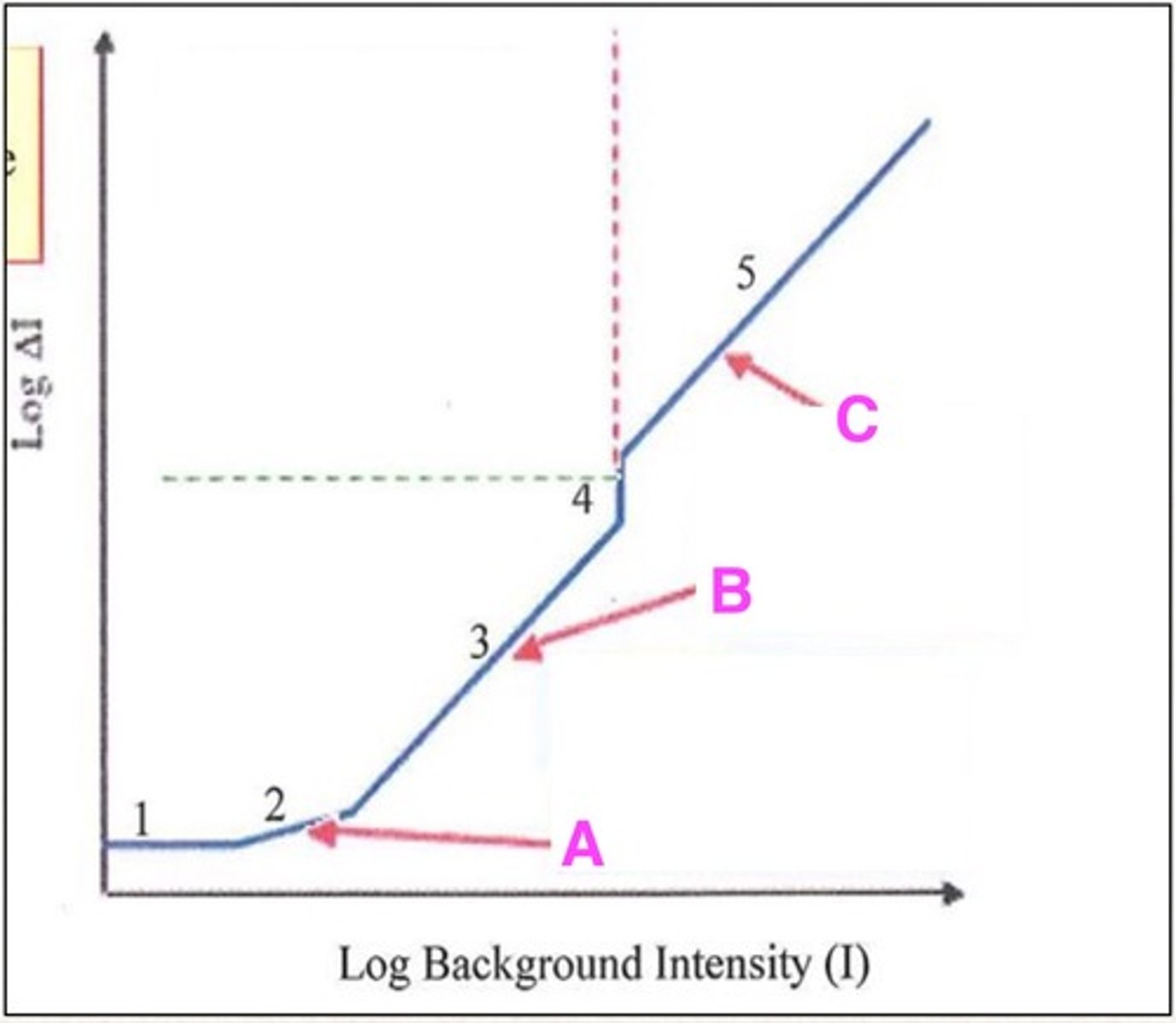
What does region 1 of scotopic light adaptation represent?
dark light
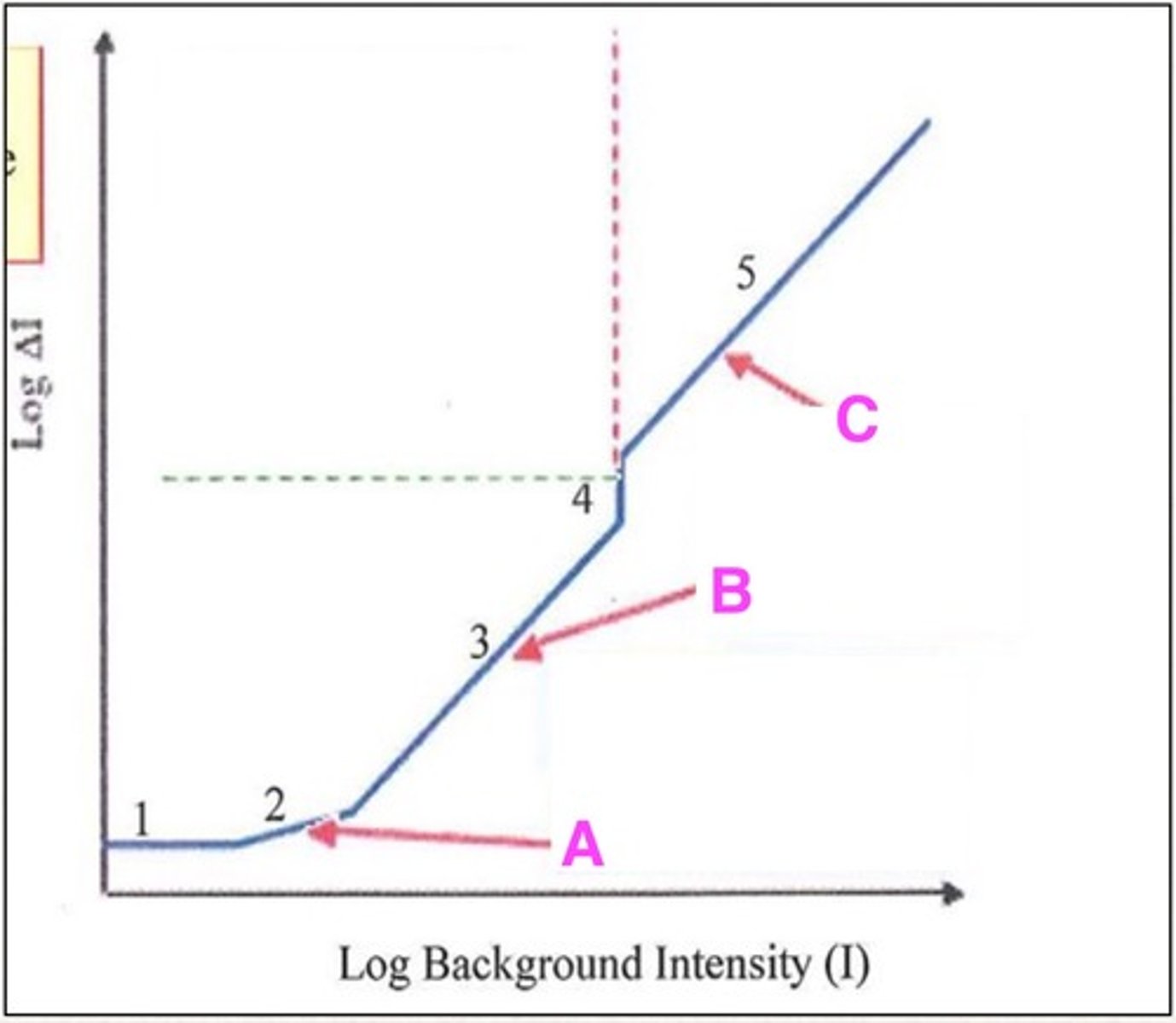
What does region 2 of scotopic light adaptation represent?
square root law/deVries-Rose law
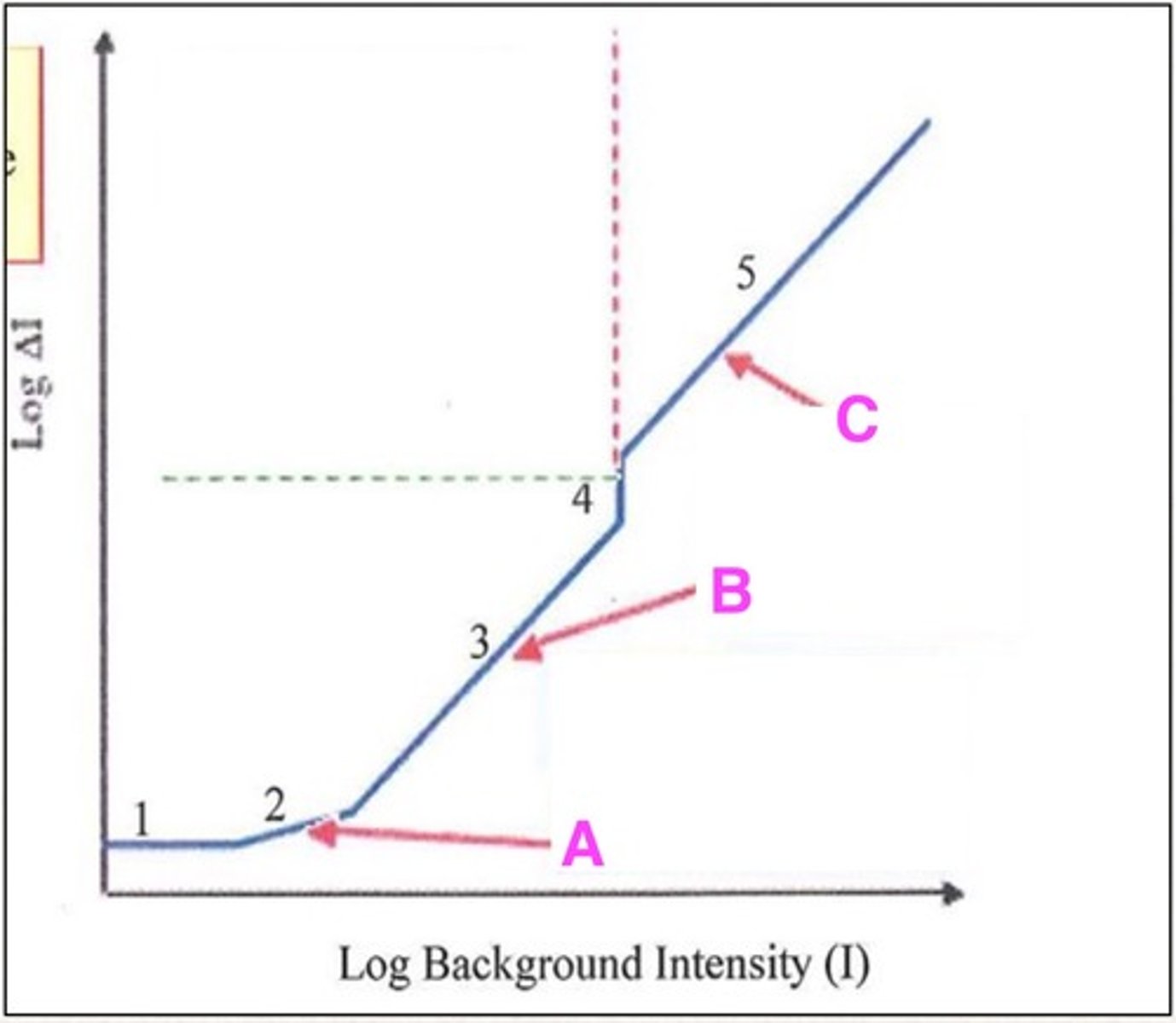
What does region 3 of scotopic light adaptation represent?
Weber's law
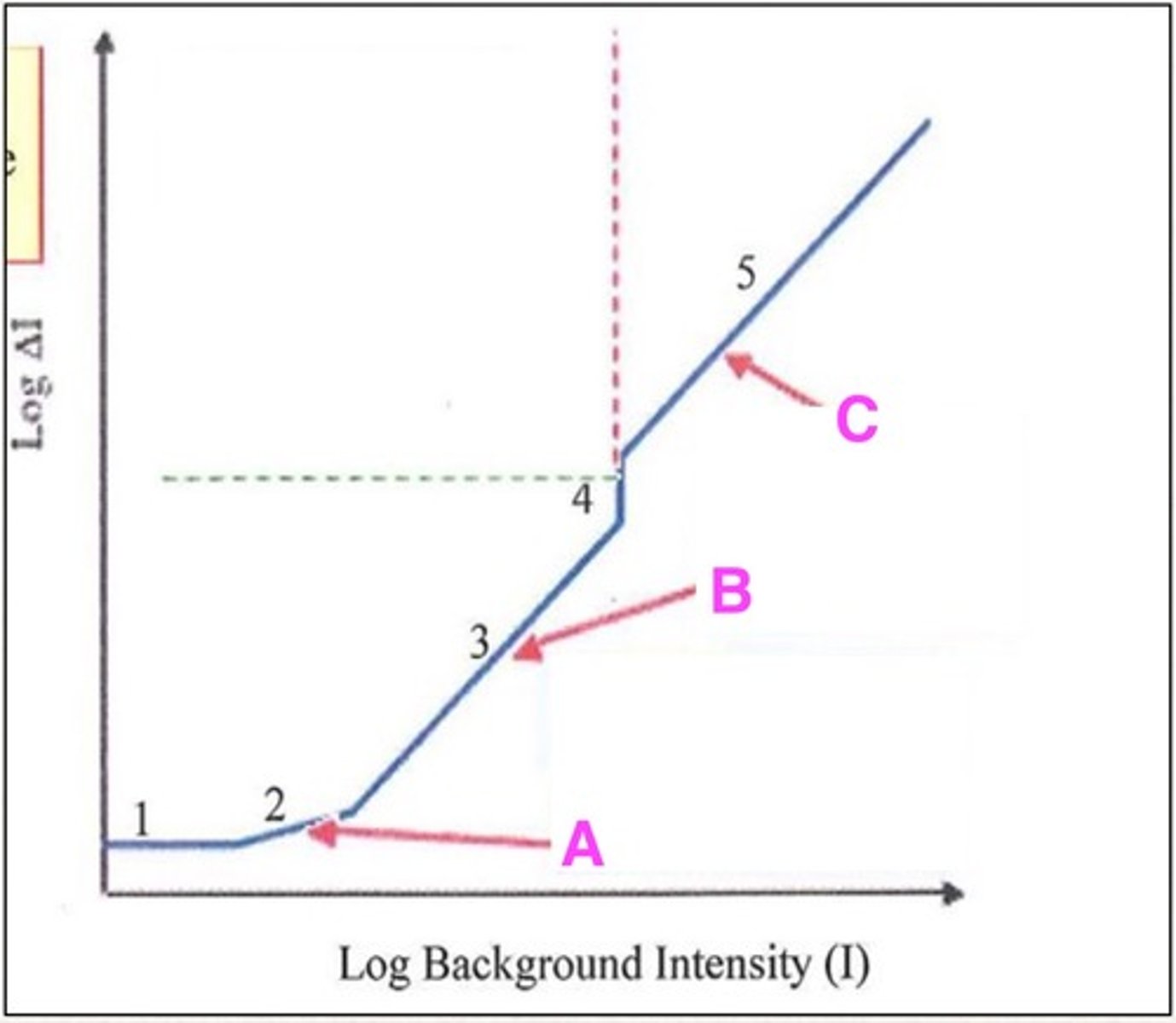
What does region 4 of scotopic light adaptation represent?
saturation
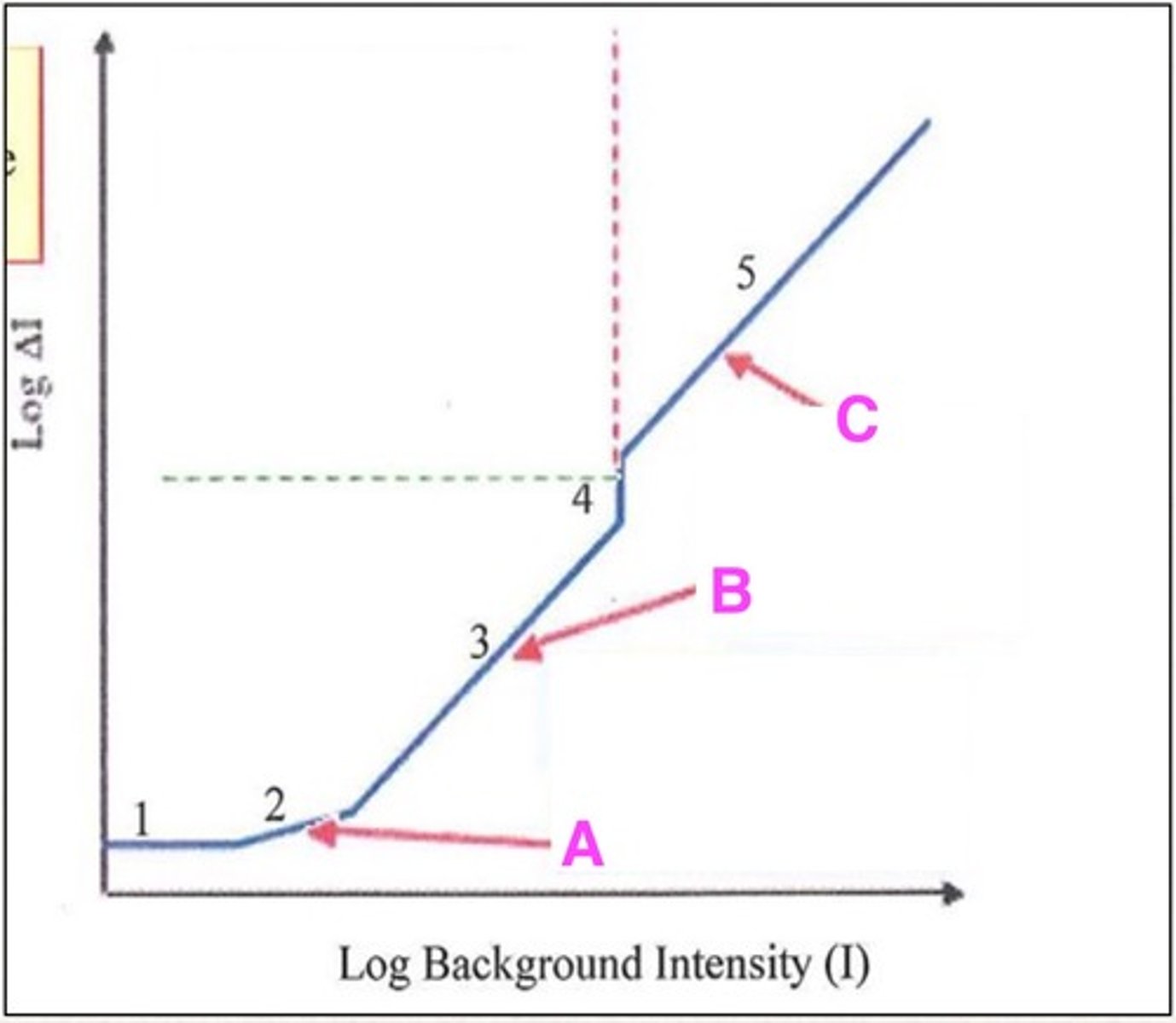
What does region 5 present?
photopic light adaptation
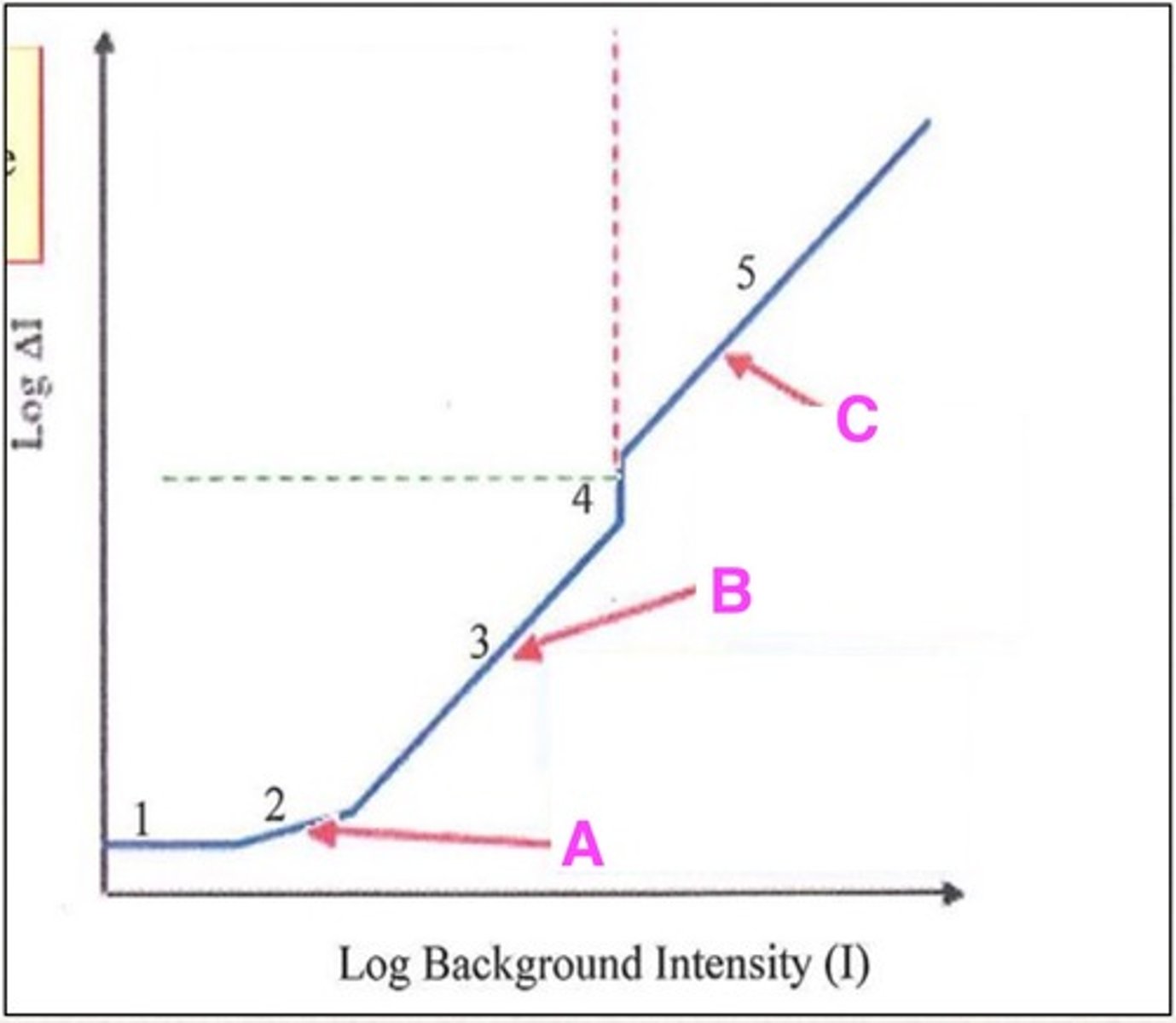
Which region(s) of the graph depend on the deVries-Rose law?
A
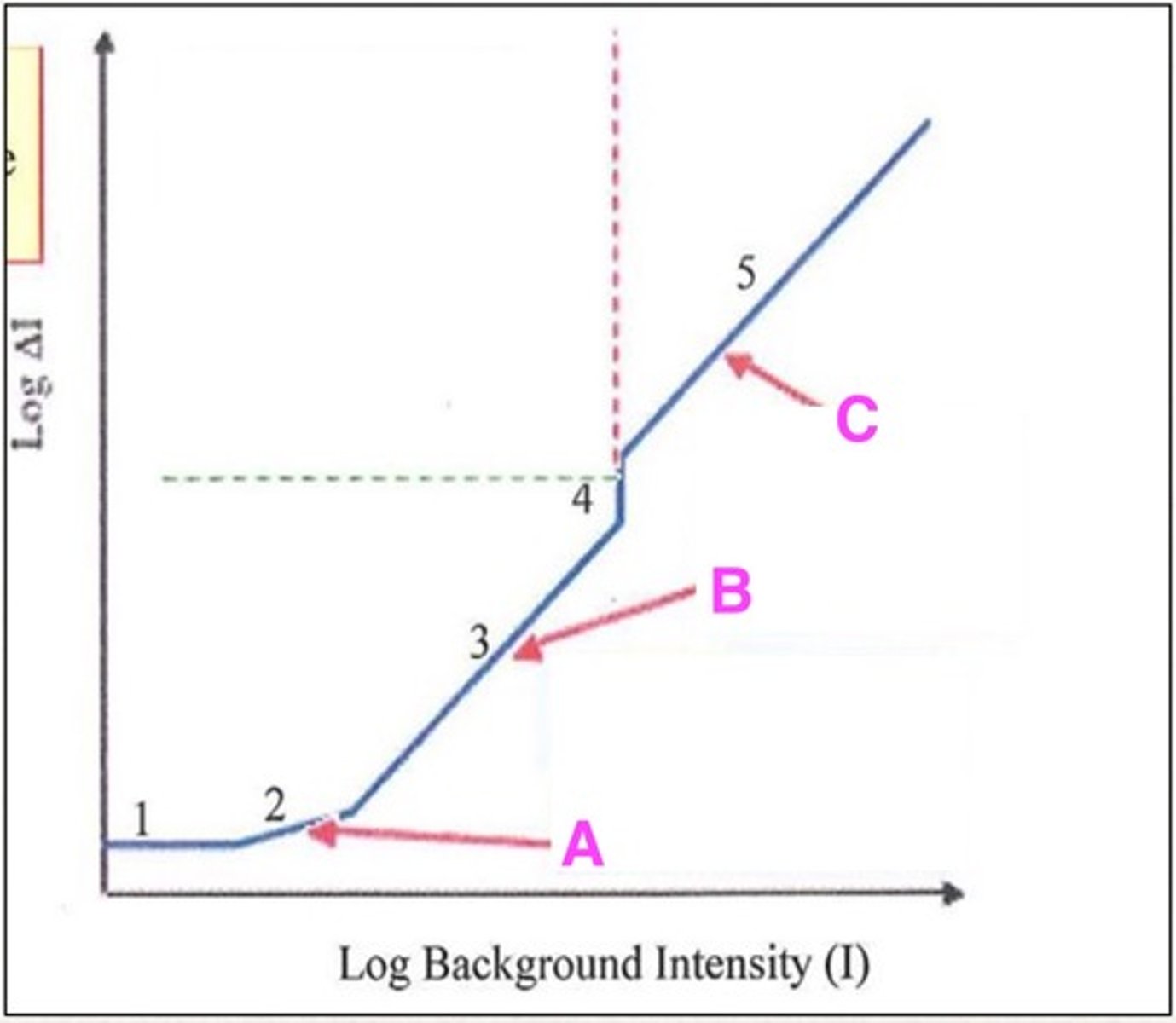
Which region(s) of the graph depend on Weber's law?
B, C
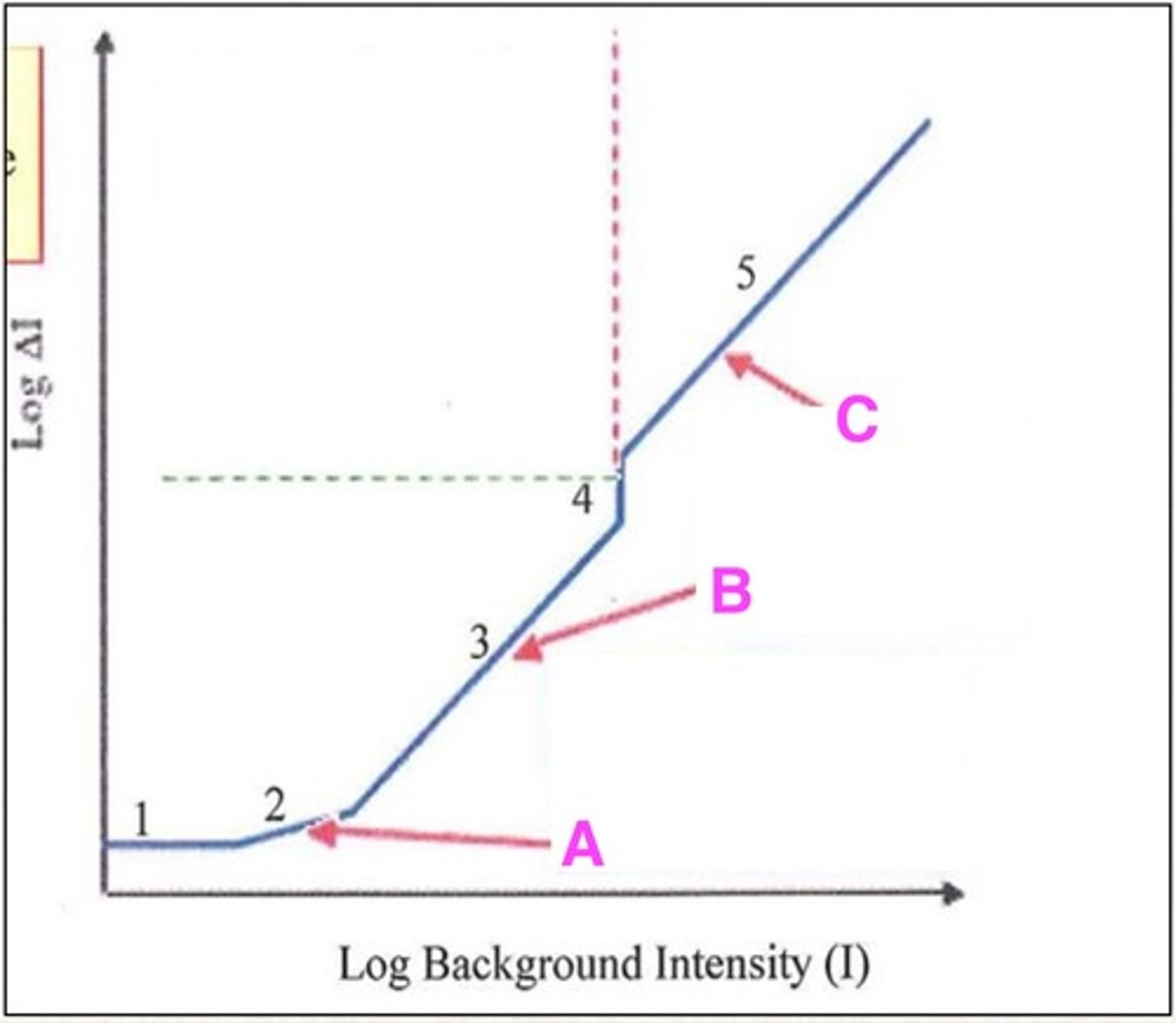
In the dark light region (1) of scotopic light adaptation, what is the slope?
0
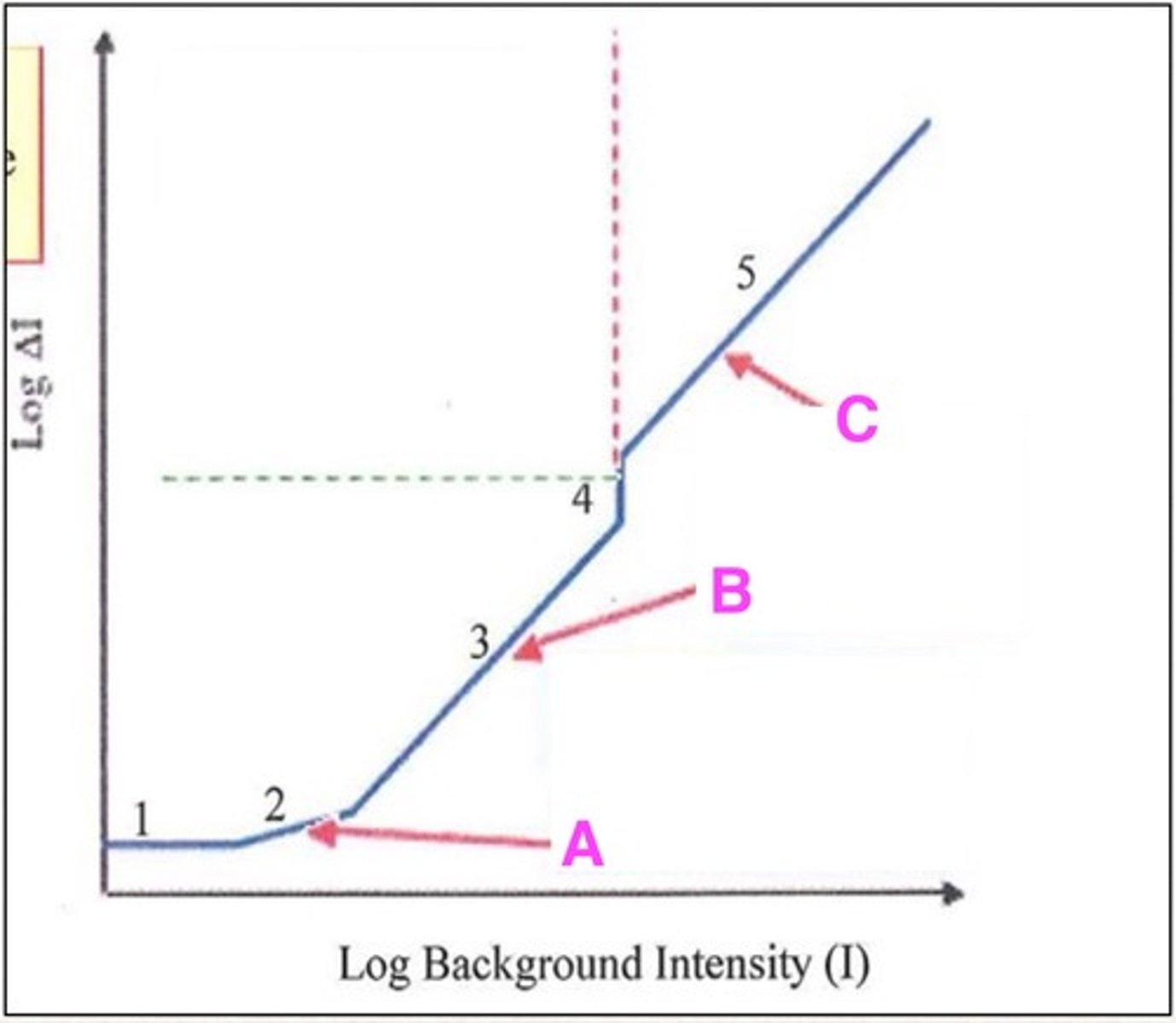
In the dark light region (1) of scotopic light adaptation, what is the relationship between increment threshold and background intensity?
independent
(background intensity is too low)
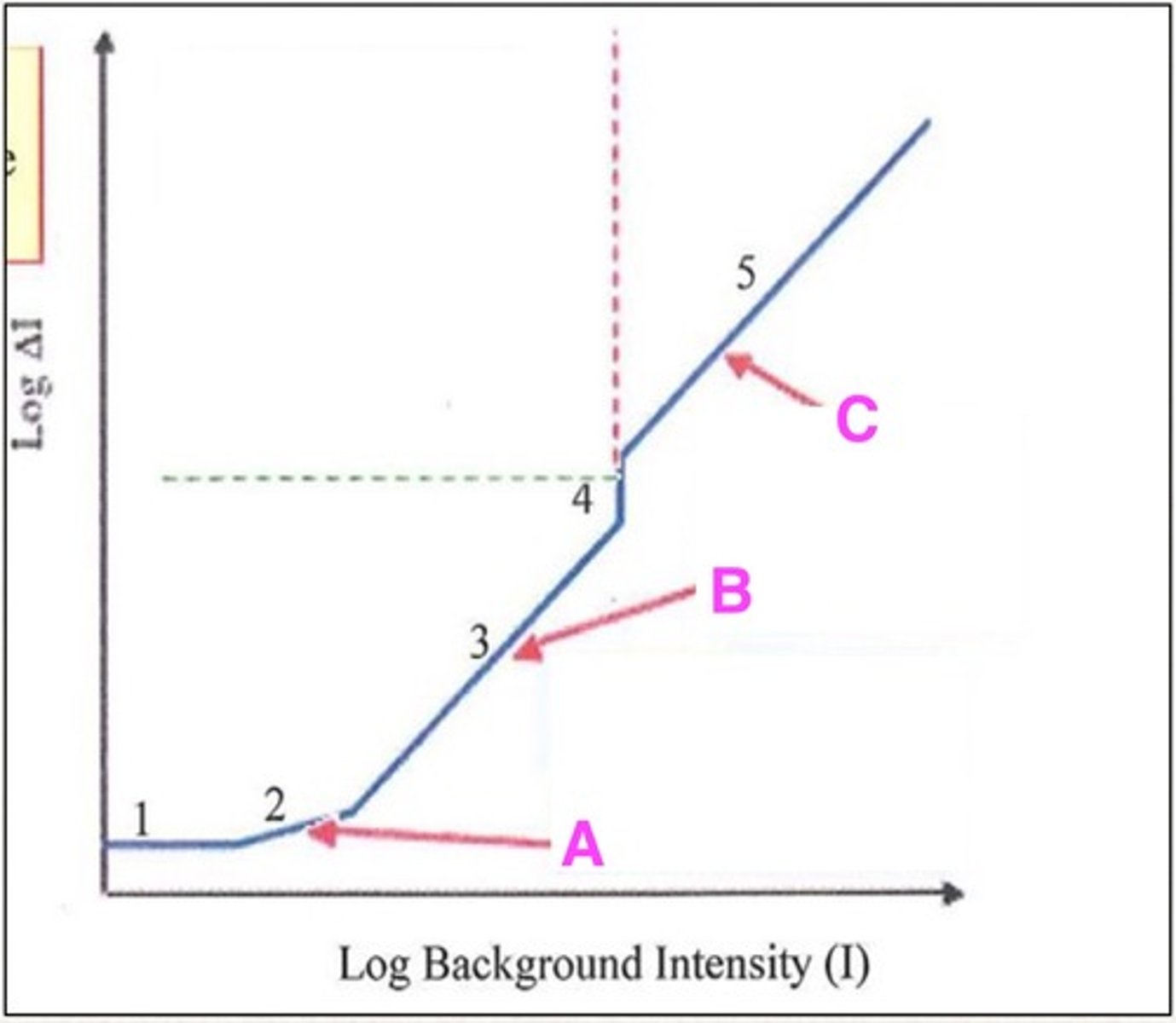
In the dark light region (1) of scotopic light adaptation, background intensity is too low to influence increment threshold. Therefore, vision is mainly influenced by what?
neural noise
(internal background firings of the visual system)
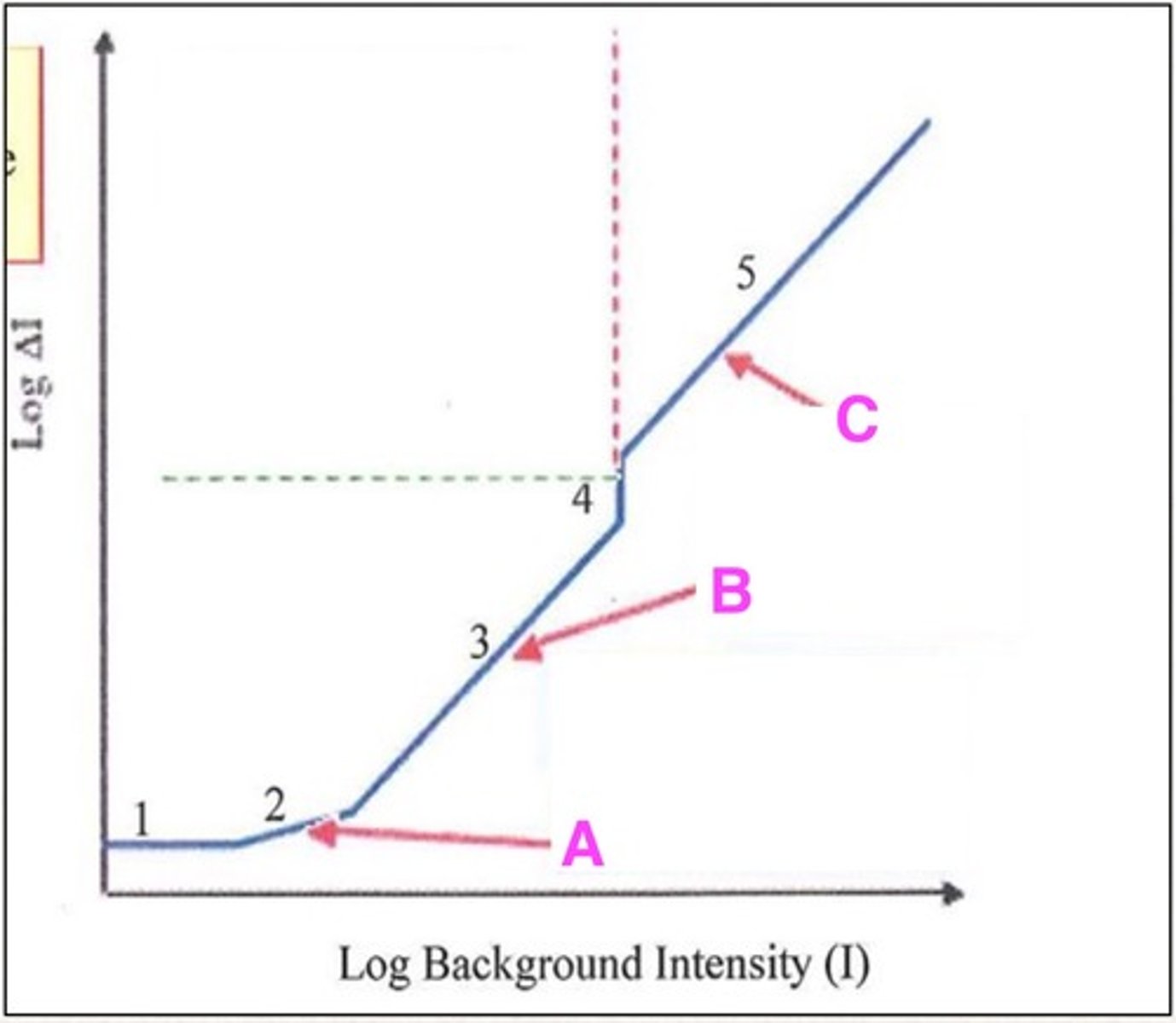
In the square root law/deVries-Rose law region (2) of scotopic light adaptation, what formula represents the slope?
increment threshold = k * square root of background intensity
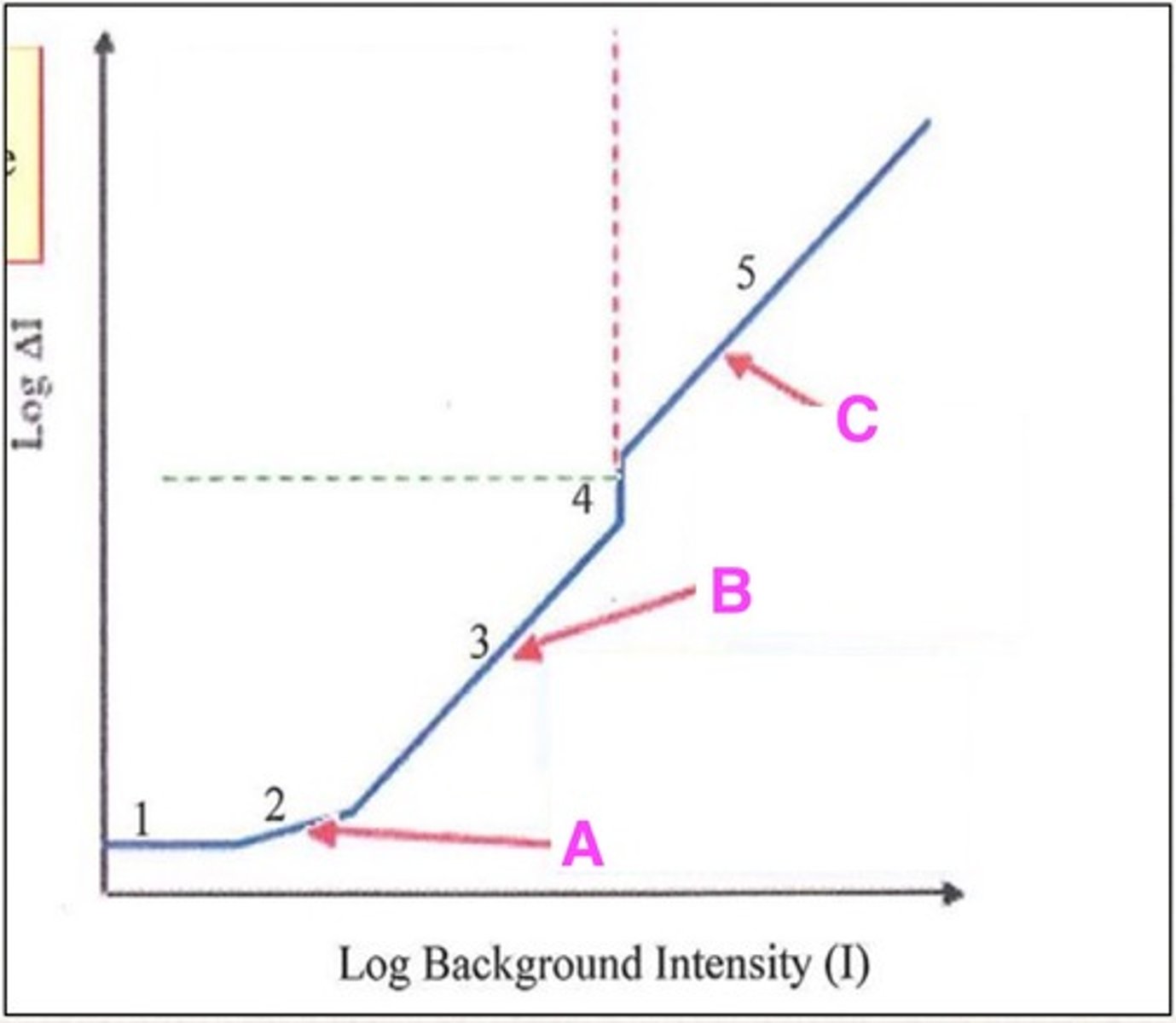
In the square root law/deVries-Rose law region (2) of scotopic light adaptation, what influences vision?
fluctuations in background light
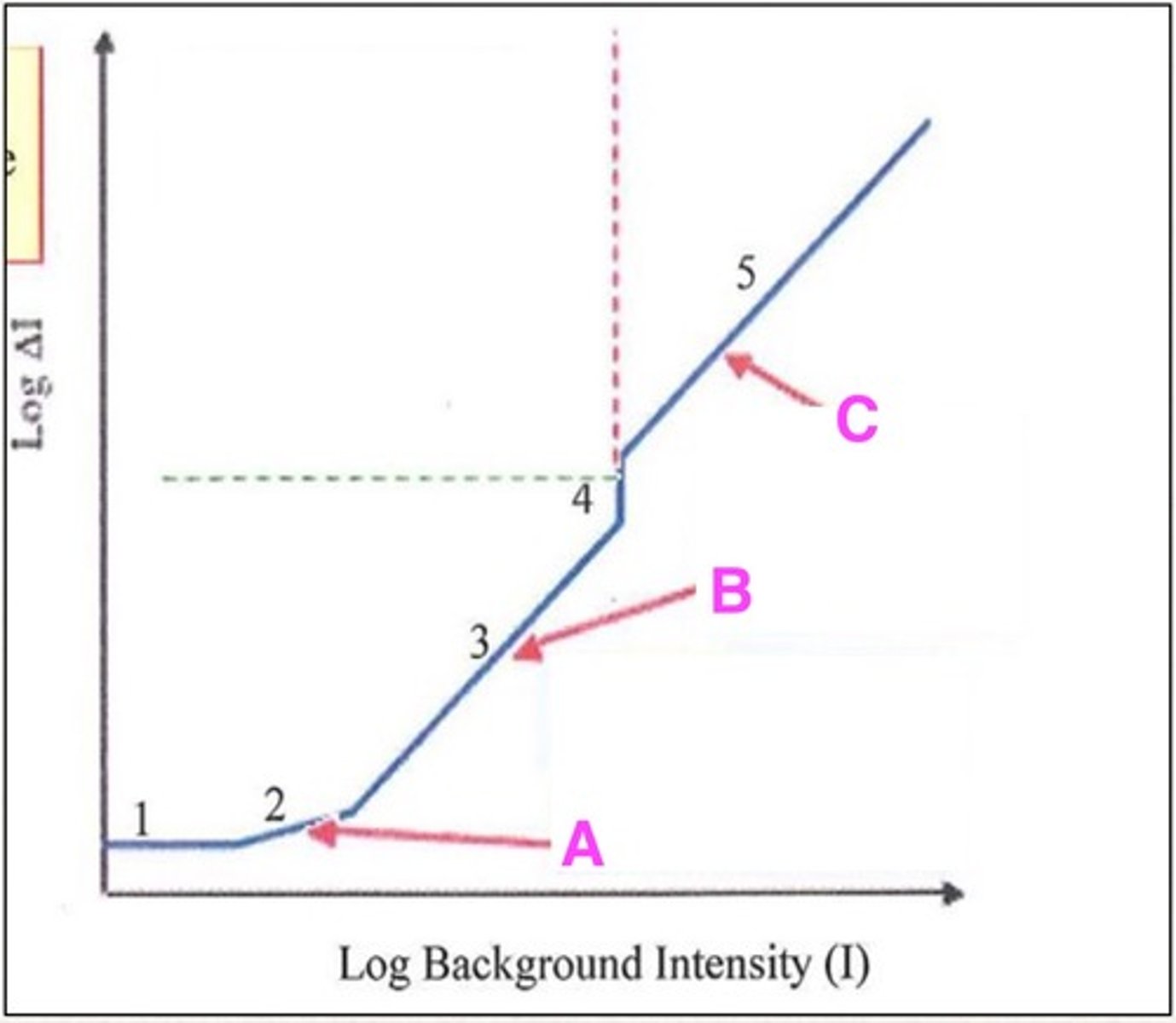
In the saturation region (4) of scotopic light adaptation, when the light level is on the scotopic/mesopic "border", what happens to the photoreceptors?
rod saturation
(rods can't take any more photons and detect any more changes in background light intensity)
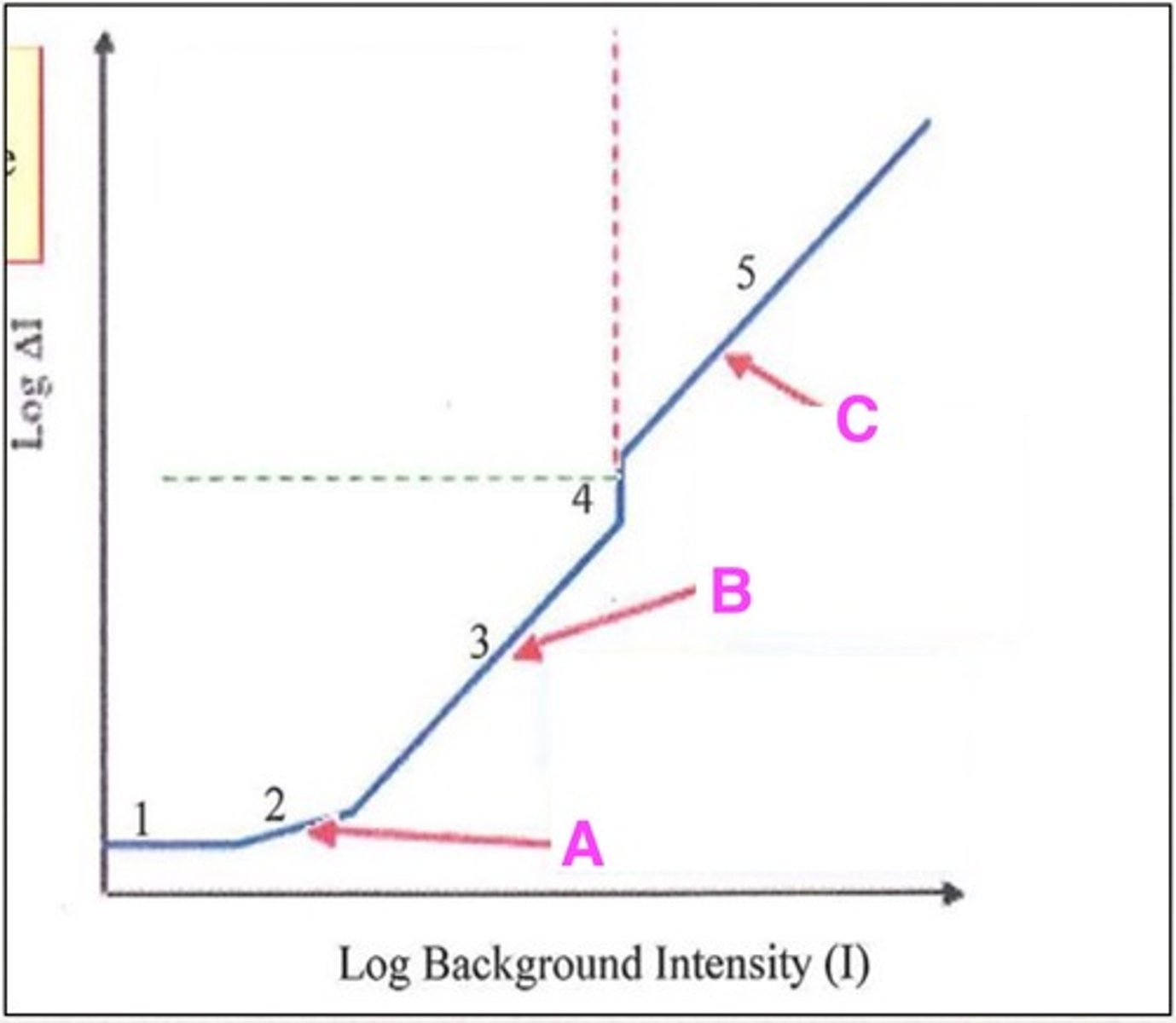
In the saturation region (4) of scotopic light adaptation, what is the slope?
infinity
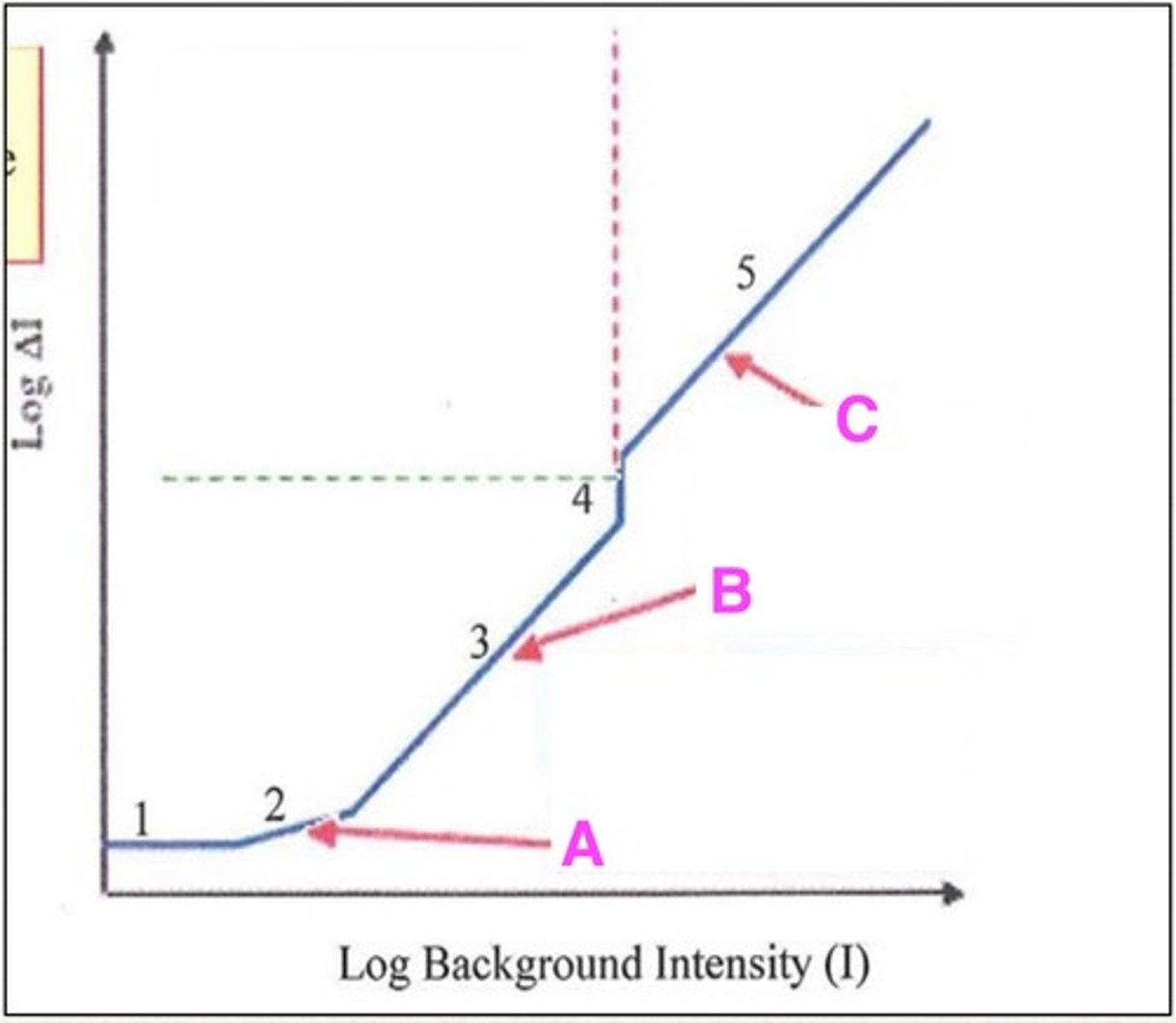
In the saturation region (4) of scotopic light adaptation, in someone with normal vision, what happens when rods are saturated?
cone system takes over
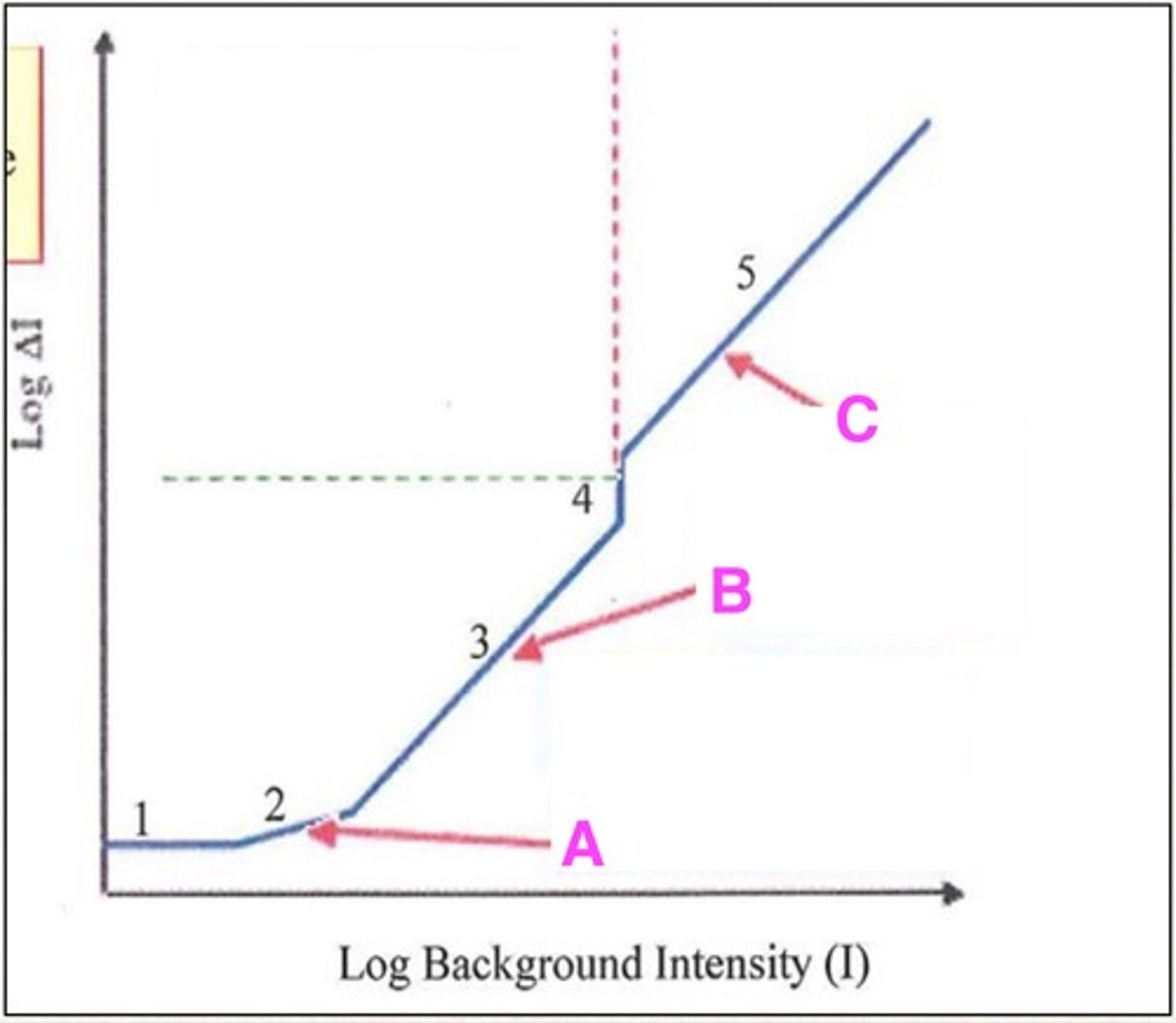
How were researchers able to figure out that region 4 is where rod saturation occurs?
used rod monochromats
(no cone function - they cannot discriminate objects from the background light that seems exceedingly bright to them)
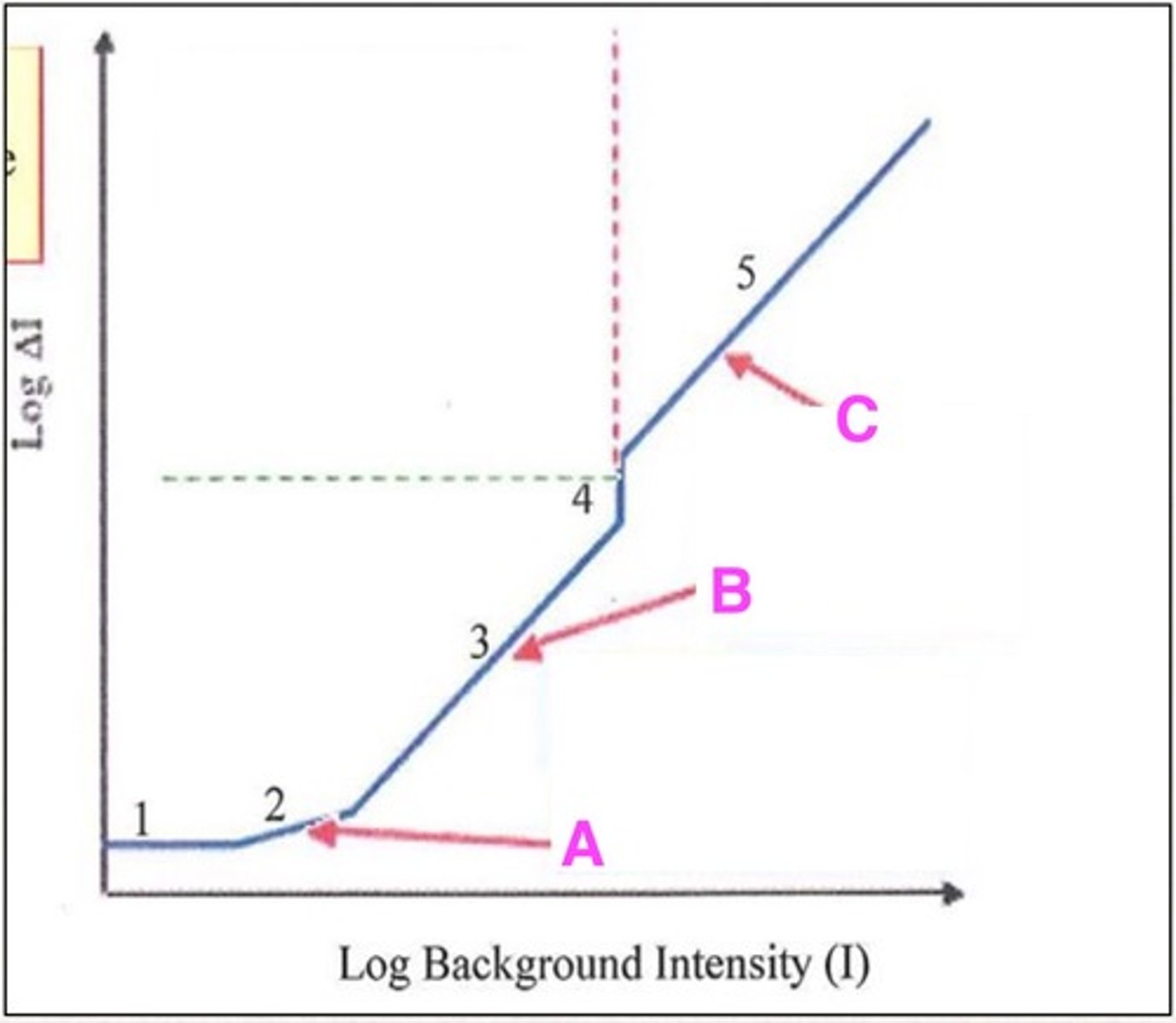
By doing studies with rod monochromats, who have essentially no cone function, researchers figured out that rods become saturated at what luminance? (cd/m²)
1000
About what percentage of rhodopsin bleached will lead to rod saturation?
10%
(when 10% of photopigments in a rod are bleached, all the sodium channels are closed and thus maximum hyperpolarization has occurred)
In the Weber's law region (3) of scotopic light adaptation and also in the photopic light adaptation region (5), what is the slope in a log scale plot?
1
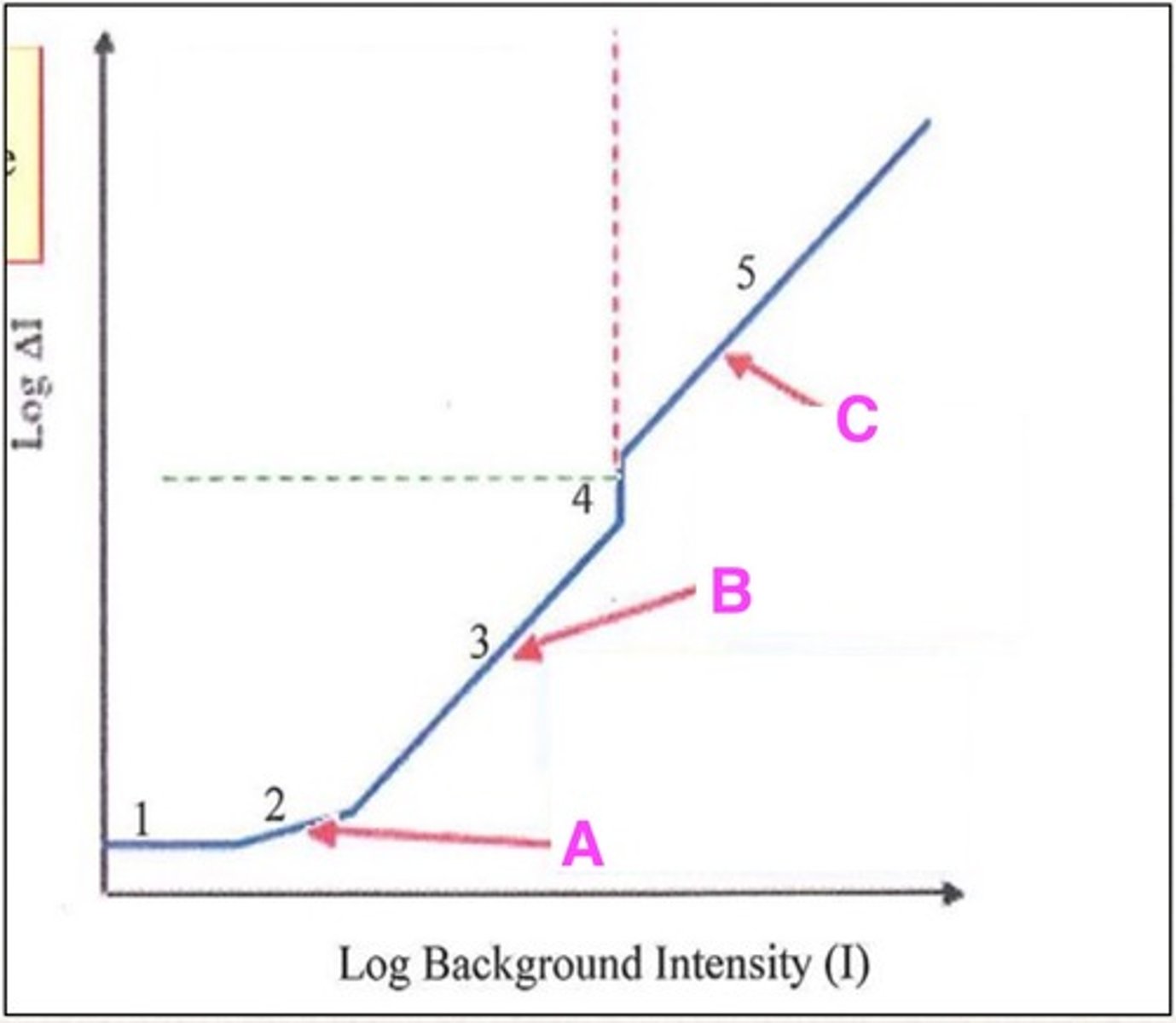
What is the formula for Weber's law, as exemplified in regions 3 and 5?
just noticeable difference = k * background intensity
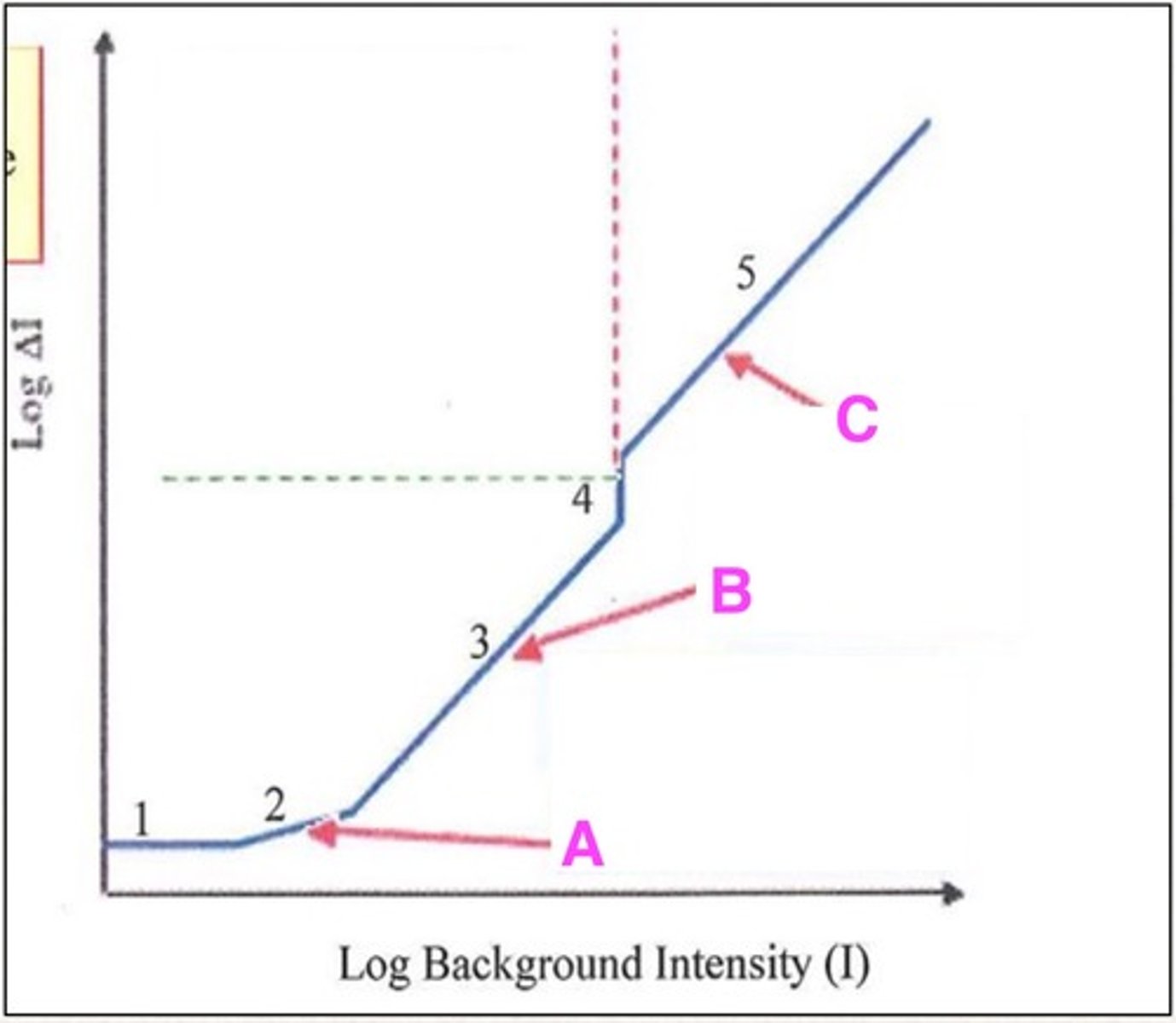
In the Weber's law region (3) of scotopic light adaptation, what is the Weber fraction (k) for scotopic vision?
0.14
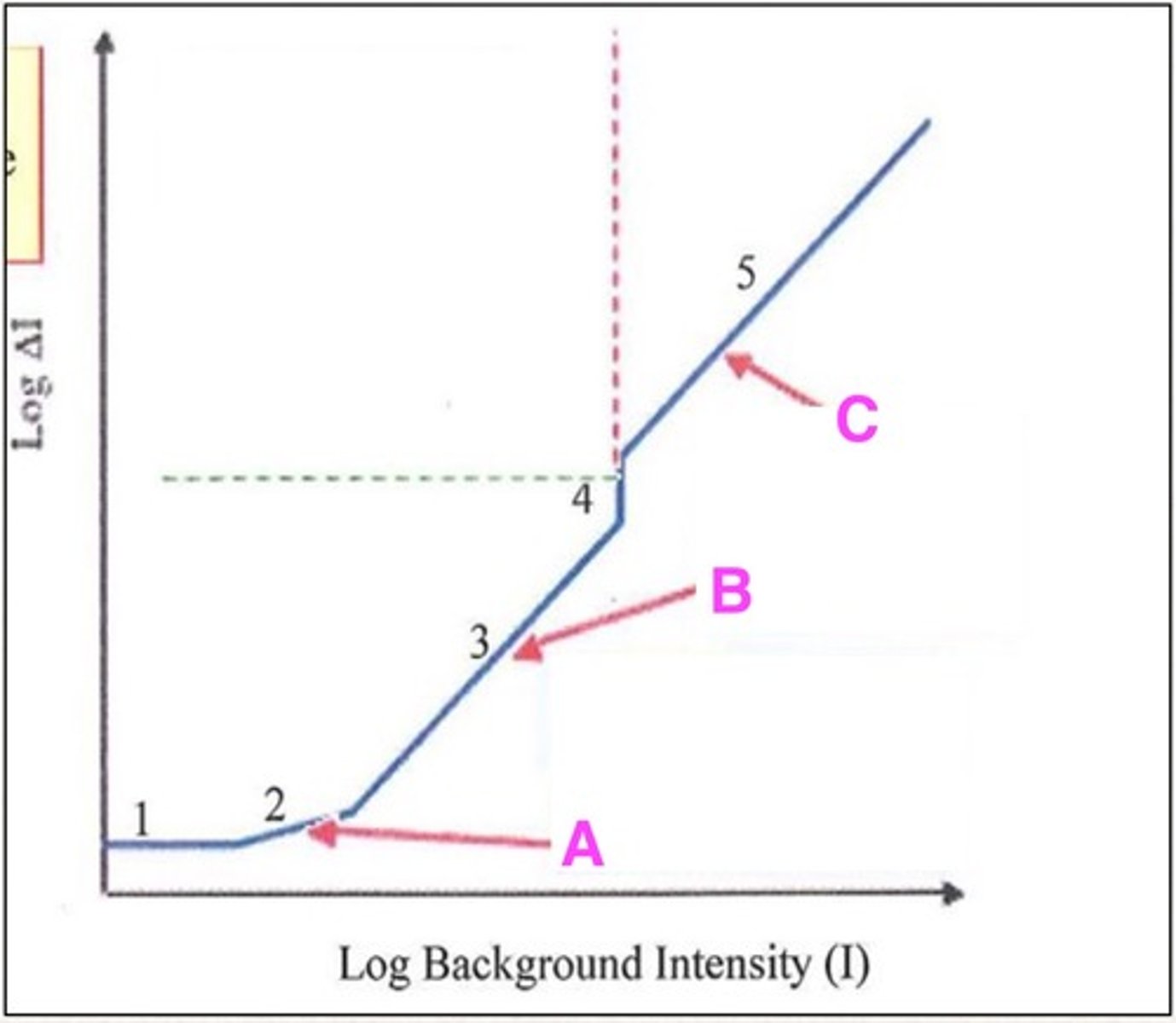
In the region of photopic light adaptation (5), what is the Weber fraction (k) for photopic vision?
0.015
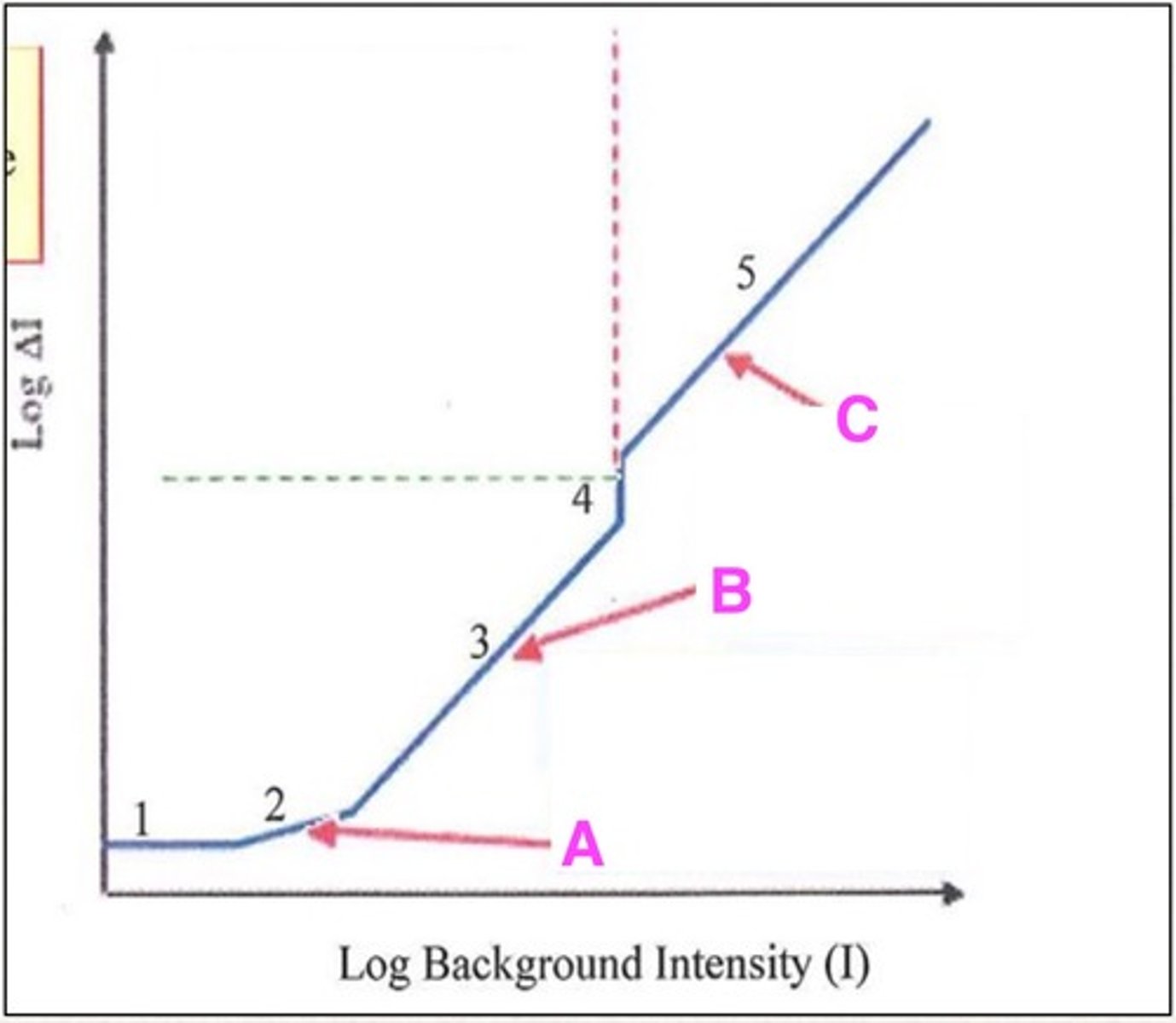
refers to the difference between a target and its background - this is the k constant in Weber's law
**this is also the contrast threshold of the visual system
Weber contrast
How do we calculate Weber contrast (k)?
increment threshold/background intensity
In the photopic system, if we have a background intensity of 100 units, what is the increment threshold?
1.5 units
(100 x 0.015)
In the photopic system, if we have a background intensity of 1000 units, what is the increment threshold?
15 units
(1000 x 0.015)
Whether in the scotopic or photopic system, what is the relationship between background intensity and increment threshold?
directly proportional
What is the relationship between absolute sensitivity of the visual system and illumination?
inversely proportional
What is the relationship between relative sensitivity of the visual system and illumination?
independent
(remains constant)
refers to the trade-off between relative and absolute sensitivity of the visual system
sensitivity regulation
Why does absolute sensitivity of the visual system change as the illumination changes?
depends on increment threshold, which changes
Why does relative sensitivity of the visual system NOT change as the illumination changes?
depends on k, which doesn't change
During light adaptation, when illumination increases, what happens to absolute sensitivity? Relative sensitivity?
absolute decreases, relative stays constant
(this is sensitivity regulation)
What is the contrast threshold for the photopic visual system?
1.5%
(from 0.015 - means that photopic system can barely detect a target light that has 1.5% contrast against a background illumination)
What is the contrast threshold for the scotopic visual system?
14%
(from 0.14 - means that scotopic system needs 14% contrast before difference is detected)
Which system is much better at detecting contrast: photopic or scotopic?
photopic
(photopic just needs 1.5% difference, scotopic needs 14% difference)
What is the relationship between illumination and contrast threshold? (within a certain range)
independent
(remains constant)
The fact that contrast threshold remains the same under a range of illuminance levels means that the visual system doesn't work like a "light meter" to accurately signal the absolute level of illumination in the surround. Instead, how does it signal the contrast of an object?
with respect to illumination
(which explains lightness constancy)
Ultimately, why does an object look the same under different levels of illumination? (Why does lightness constancy occur?)
contrast of the object remains constant
(and this contrast information is what our visual system uses as the basis to judge the appearance of an object)